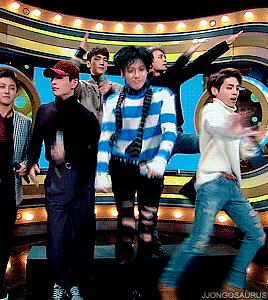Text
You can't call yourself a fan if you:
1. Attack members of the group you stan (why would you ever) 2. Say another member is getting undeserved love/attention (almost every idol I’ve seen deserves love and attention) 3. Call members ugly (they probably aren’t) 4. Calling another group’s members ugly (how dare you) 5. Blame a successful member for the misfortune of the other member or members. (They have no control over how they’re being promoted or how their albums sell) 6. Hate a member (probably for no good reason) 7. Attack other groups or provoking other fandoms (mind your own business) 8. Hate other groups (also for no good reason) 9. Hate girl groups (why would you ever. They are great) 10. Hate a member of a girl group for just looking in “oppa’s ” direction (so tired of seeing this) 11. Use girl groups for only shipping purposes (don’t get me started) 12. Over sexualizing under aged member of any gender (they are tiny babies. Leave them alone) 13. Blaming/insulting a member for doing something they were told to do or had no control over ( It’s probably not their fault)
I probably missed somethings add if you like but as always please be polite.
938 notes
·
View notes
Text
So by army’s logic if bts ‘paved the way’ then why are you trying to push SuperM, NCT, and basically every other group off the path?
143 notes
·
View notes
Text
Super M fan sign
I got Ten and when we were talking he complimented my eye makeup. Ahhh I’m dying.
#Ten#super m#superm#shinee#kpop#nct#exo#taemin#kai#fan sign#taeyong#baekhyun#mark#sm#sm entertainment#wayv ten
52 notes
·
View notes
Photo








“This is SHINee FIVE, And we’re right by your side”.
3K notes
·
View notes
Text
Red Velvet’s Bad Boy MV (Music Video Analysis)

The views presented in this theory are a part of my own individual interpretation of the video, which means they are subject to error. Lyrics taken from kpopviral.
The Treachery of Images: I’ve just posted an analysis for Peek-A-Boo, which deals heavily on the inversion of male fantasy. The theme carries over into this video. Though the title is “Bad Boy,” no boys are present. The focus on the video is entirely femininity, which makes sense when taking into consideration that the term “bad boy” is almost always defined in opposition to the “good girl.” Take Grease for example. Sandy is a good girl who has met a bad boy, and the film concludes with her transformation over into a bad girl. In this dichotomous presentation of femininity (meaning girls are only either innocent or corrupted), the bad boy is the means by which the girl is transformed. Good girls are seduced by bad boys, and ruined.
Here, however, Red Velvet has more agency than that. The lyrics address the bad boy in question as they attempt to seduce him.
You must be confused, you can’t even imagine
You can try to get away but there’s no room at all
The answer’s decided, you follow me naturally
I choose you, I already chose you
Though they play out both the roles of the “innocent” and the “corrupted” they ultimately seek to destroy the constraints these images place upon them.

As the video opens, the members sit in an empty hot tub while wearing school girl uniforms. The uniforms are typical of representations of young girls, both used to show innocence and eroticism, so we are introduced early to the dichotomy at hand. The image of the hot tub, as well, is suggestive, though empty. The voyeurism of girls (even clothed) in a hot tub is disrupted by the falling snow, and the book.


The theme of voyeurism is present throughout the video, especially as the camera essentially “intrudes” upon the private setting of Joy and Seulgi in bed, confiding in one another. These voyeuristic and homoerotic elements play into the male fantasy of what happens at sleepovers, acted out by the camera.
Like with the snow, this image is interrupted by the inclusion of the book.


The book cover reads “Ceci n’est pas de la levre,” mimicking Rene Magritte’s famous painting The Treachery of Images. The text translates to “this is not a pipe,” which appears paradoxical at first. However, it is not a pipe, but the image of one. Though the book’s French is not correct, it should say something along the lines of “these are not lips.” What it stamped on the cover are not lips, but the image of lips.
The treachery of images is that we forget they are images. We believe them so wholly that we take representation as truth. This theme is central to the understanding of the video. We must remember what we are seeing isn’t trustworthy: it’s just an image. This is so brilliantly put in terms of femininity with lipstick rather than the male-coded pipe.
What we see throughout the video are not true images of femininity, but constructed images and conceptions. This can extend beyond the theme of femininity I’ve focused on, to just the simple image of being in the public eye. An “idol image” is not a complete and full person, though people often make this mistake.

Here we come upon one of the main settings of the video. A red bed sits in the middle of a road in an icy place. Four of the members lie in bed. (I think Joy is missing, but there’s no reason I can think of why Joy specifically would be missing, so I’m going to assume it’s not important.)
This scene presents a set of contradictions. The setting is cold, while the bed is a symbol of rest and comfort. There’s a suit case, and a street, which imply movement and temporary stasis, but the bed, again, implies permanence. Cold versus comfort, temporariness versus permanence in this dream-like setting communicate their conflicted emotions concerning the images rendered of them. They are uncomfortable and comfortable at once, tempted both to stay and to leave.
The girls sleeping in the bed, again, tie into a voyeuristic theme. Their unconscious state makes them vulnerable, as if they are unaware of the camera and lack the agency to break free of the watchful gaze of the camera.

In black and white, suggested to be on a different time line than my previous screenshot, Seulgi walks toward the bed alone with a suit case in hand. This symbolizes her entrance into this isolated and emotional landscape. The suitcase indicates her intention to stay, at least for a while, before the eventual decision to leave.
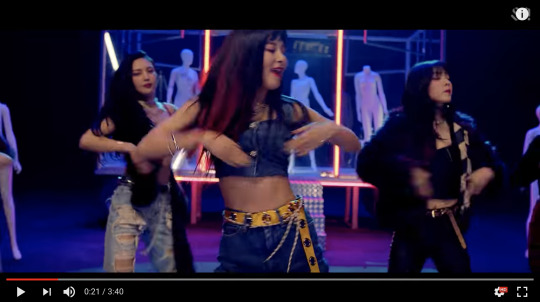
Much of the video takes place in this setting. The girls are dressed in stark contrast to their earlier sleep over attire. Where that was the image of innocence and soft femininity, here they display something closer to the “bad girl” image.
This setting is also decorated with female mannequins. They are approximations of the female form (a representation and not a truth), and they are idealized and commercialized objects meant to sell clothing. These mannequins represent the battle of representational and true female identity–they present an ideal body but are not an actual body. Where women are often made over into idealized, commercialized objects (typical in the k-pop industry especially), we must remember that the image of such women are only images, and that people exist behind them.
Additionally, though I haven’t captured this in the screenshot, the platform on the back is on wheels, again suggestive of impermanence.
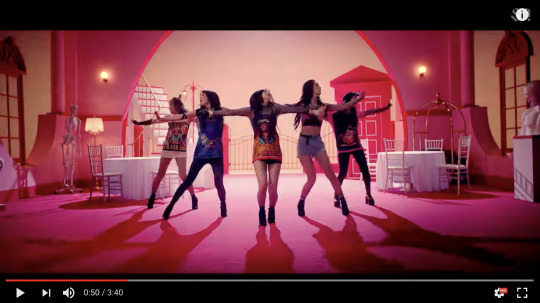
This is the third key setting of the video. With tables and a staircase and a front door, the room appears at first to be a home. However, there is a luggage cart in the corner, revealing the potential domestic setting to be a hotel lobby. The hotel carries on the theme of impermanence, and ties back to the suitcase Seulgi carries.

Here Yeri displays the sleep over image of soft femininity.

She presses the typewriter key and the screen ripples.
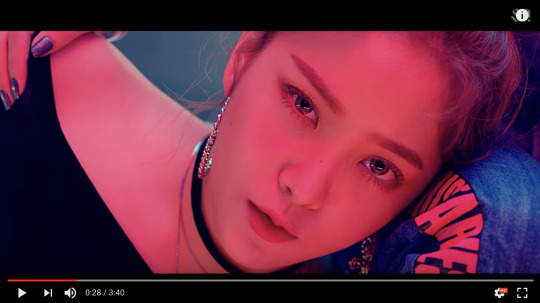
She falls into this “bad girl” image–the transformation complete in one moment. She is the innocent made corrupted at the press of a key.
Throughout the video, the girls whisper in each other’s ears. They confide in one another, but we do not hear what is said. The camera (often pictured in this video as a polaroid) captures images and is unconcerned with the things they say. The image of femininity is unconcerned with actual thoughts and speech of women–they can speak and confide in each other in private circles, but they are not meant for public speech. Yeri’s utilization of the typewriter implies an attempt at language, at communication, which amounts to the act of rebellion. The desire to be heard is the “corrupting” force.

The members sit around a table in the hotel setting. They have the books on plates, and they read the books despite the blank pages. As will be seen a few screenshots later, the only book with text in it is the book with the lips on the cover. The reading of the blank books signifies the expectation to swallow empty ideas because they are presented in a convincing light. The books are physical, real, and from the opposite side you can believe they contain knowledge, though the inside is blank. These books give the image of knowledge without knowledge.
Only the book in Wendy’s hands is effective. The other books still read “this is not a lip” on the cover, and this statement can be taken literally. True, there are no lips on the cover. The paradox doesn’t work here. Only paired with the image of the lip can the book call attention to the treachery of images and communicate true understanding and knowledge.

The five of them walk with destructive items in their hands–bats, spray paint, etc. We see these items appear throughout the video. Keep in mind for later


Wendy, having possessed the book that called attention to the treachery of images, has a camera placed before her. She burns it, destroying the thing capable of capturing images. In the destruction, she alerts the others of the problem with the structured images, as Seulgi and Joy are entranced and fan the flames.

Despite burning the camera, the images remain, as five polaroids are tucked into the book. One for each member, these polaroids represent the conceptions and images that surround them. Though they have destroyed the camera, there is a certain sentimentality in saving the images–they’ve grown attached to them. They hide them away for safe keeping in the very book that condemns their treachery. They know the danger of the image, but it is not entirely constrictive. It’s familiar, just as the bed is comforting, just as they might be tempted to stay. This is another instance of the struggle of whether to break free from the image or not.



The girls begin to destroy both the mannequin and the hotel setting. This destruction, especially through vandalistic means such as graffiti, is a “bad girl” action. At first, the destruction appears simply rebellious and typical of the personas they embody.
Additionally, Wendy knocks the camera out, sending it spinning. This calls attention to the fact that we are watching the video through the lens of a camera. The things we are seeing are mere representational images.
The mannequins, as well, have been knocked over, and all they represent as been displaced.

Irene covers Yeri’s ears in the approximation of hear no evil. The eldest protects the youngest. This reflects the fear of influencing young girls, a fear that reveals the belief in their inherent corruptibility.
Fun fact: they used to think women were so impressionable that if they looked at something bad while pregnant, it could lead to a deformity in the child.
The assumption of being so easily influenced supposes they lack the agency to interpret the information they hear correctly.

Seulgi stands in the black and white bed setting, aiming gun at seemingly no one.

As Wendy burned the camera, she now holds a lighter.


Seulgi squirts strawberry syrup onto a white cake and the stuff drips over the sides. On first glance, it looks like blood, which is a purposeful mislead. It’s hard to catch the edge fo the bottle in Seulgi’s hand. We are supposed to think it’s blood when it is nothing more than syrup.
Unlike in Peek-A-Boo where we see violence practiced, Yeri shooting the crossbow and cutting the boy’s cheek, Irene slicing Seulgi’s cheek, all of the violence in this video is sublimated. Seulgi points a gun but it’s at no one and she never pulls the trigger. We see the shocking image of blood and it’s revealed to be nothing more than syrup. Irene poses with bolt cutters, but we never see them used. We see Irene and Yeri posing with spray cans, but the destruction is in the background already performed. Later, when the room burns, we only catch a glimpse at the flames. The destruction and violence are shown in glimpses and never in full–subverted.
This plays into the treachery of images, how little we see and do not see, and how much we can assume with just the glimpse of a thing.

Seulgi stands on the table, blowing fake money. The fake money is the illusion of luxury and not the thing itself. Though she dispenses it, none of the girls reach for it. Later, they stand under it in marvel, as it were falling snow, but they do not collect it. They understand it is worthless.

Wendy sleeps with her head down. Behind her, a member passes by while a shadow hand reaches out. A second later, Wendy’s eyes open. This connects to the sublimated violence, being unaware and stalked. It also calls attention to the theme of sleeping and waking-what happens while you sleep and what is necessary to wake to awareness.

Earlier, Seulgi had the gun pointed at no one. I think it’s necessary to point out that Seulgi very clearly has the gun pointed at the viewer, at the camera. She has aimed her gun toward the constructed image.

Where they were asleep previously, the girls sit up in bed and they seem aware of the snow for the first time. Their agency is expanding.


Here, more voyeuristic and posed images of homoeroticism play out. Irene and Joy are frozen in a near kiss. They coyly whisper in one another’s ears. This is not a natural closeness. Yeri and Seulgi look knowingly into the camera, calling attention to the fact that this is for the benefit of the camera.

Seulgi picks up the suitcase and leaves.

The bed in this setting, an object of permanence, is replaced by a car. It’s an object of agency, giving them the ability to come and go as they please.


Wendy tosses her lighter, and the place goes up in flames. The setting indicative of their bad girl image is destroyed.
They demonstrate the agency to come and go, to preserve and to destroy.

The video ends as the girls open their eyes, staring up at the camera while still dressed as innocents. In the end, they present their own individual identities, unified by the innocence of the sleep over setting and the graffiti on the floor. Though they perform the destructive act, which is a “bad girl” thing, they end the video in complete awareness and in the state of innocence, navigating between the two roles in the suggestion of unity. They are capable of both goodness and individual will. The act of destruction was not simply vandalism typical of one role, but the expression of will and individuality. They destroy the image that would divide female identity in half. They can destroy and preserve and be good. They can be awake and aware and innocent. They aren’t good girls gone bad, they’re simply girls capable of complexity and agency.
158 notes
·
View notes
Photo










“there is no shortcut to perfection. all it takes is hard work and more hard work”- kim jonghyun
수고했어, 김종현. 정말 고생했어
19K notes
·
View notes
Text
Red Velvet’s Red Flavor MV (Music Video Analysis)

The views presented in this analysis are a part of my own individual interpretation of the video, which means they are subject to error. This post is based off of the MV from the SMTOWN Youtube channel. The video is very quirky and I’ve been kind of disconnected from the fandom lately, so if the members mention anything about the meaning of the video, please go again and message me.
Fruit: So, Red Velvet has come back with a rather…unique concept. Each girl has been assigned a different fruit based on their color: Irene is watermelon, Yeri is grape, Seulgi is pineapple, Joy is kiwi, and Wendy is orange (why couldn’t they have just made Wendy blueberry?). The song is called Red Flavor, so it makes sense to assign them each a fruit that would give them a specific flavor. But that doesn’t explain why each member is interviewing a fruit version of themselves…my theory is that the video is a coming of age story. The most important thing about fruit is that it has to be ripe for it to reach its best flavor point. As the girls age and mature, they “ripen” and reach an age where they can enjoy the sweetest part of life.
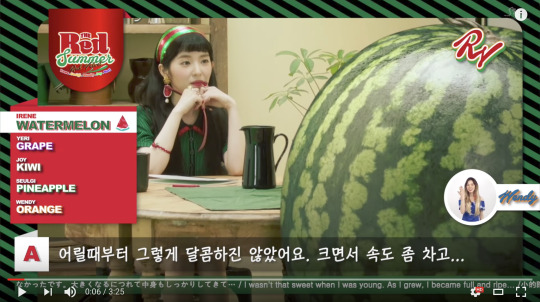
The video includes scenes where the members are interviewing their respective fruits. It appears like a newscast, with ticker tape, and a different member translating in sign language.
The ticker tape reads: I wasn’t that sweet when I was young. As I grew, I became full and ripe.

Later, the video switches things around, having the kiwi interview Joy instead.

Or a watermelon interviewing a watermelon.

And then finally reveals multiple versions of Seulgi interviewing herself, and even running the production. As they interview the fruit, they are really interviewing themselves. The surreality of fruit interviews and multiple Seulgis can be attributed to an almost subconscious state. Rather than literally interviewing fruit, each member is figuratively reflecting on their past selves, reflecting on their own stories, their youth, and their current lives.

Keep in mind the subject matter of the ticker tape interviews.
I wasn’t that sweet when I was young. As I grew, I became full and ripe.
Back when I was a child, I wasn’t tough like this, I was very weak.
That I have to say goodbye to my friends.
I used to dream of becoming jam when I grew up.
During my childhood, I was very mischievous.
(I wanted to be) Ice cream!
Sometimes I’m not even sure who I am.
As an only child, I always used to play alone.
I haven’t included everything, but the things included in the interview show a reflection on childhood emotions and aspirations, and a comparison to current life. As children they faced hardships, like having to part with friends. They experienced weakness and loneliness. They dreamed of becoming things like jam and ice cream in accordance to the fruit theme, showing somewhat unrealistic aspirations for the future. As they grew and matured, they could become strong and “full and ripe,” but they might still experience issues of identity, as with Yeri’s interview line: Sometimes I’m not even sure who I am. This reflects the transition from childhood to young adulthood.

We see a childhood photo of one of the members. I have no idea who it is or if it’s even an actual childhood photo, but it’s shown during Irene’s clip so for the purpose of this post I’m going to say it’s Irene’s childhood photo. The childhood photo explicitly introduces the comparison of youth.
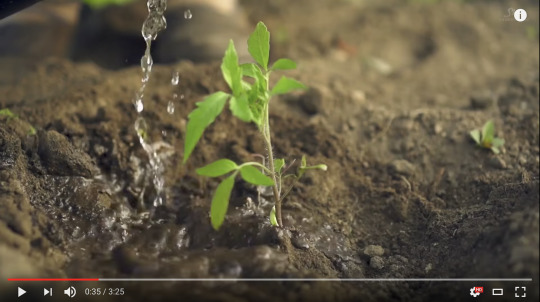
A few seconds after the shot of baby Irene, we see a little sprout being watered.

And then immediately after we get a shot of a child being rained upon. The juxtaposition of the childhood photo, the growing plant, and the child all show the connection between growing fruit and growing children.

A couple seconds later we get a shot of a giant orange tree, in contrast to the small sprout. Again, there’s contrast between youth and maturation.


Then we see Irene recreating a childhood photo.
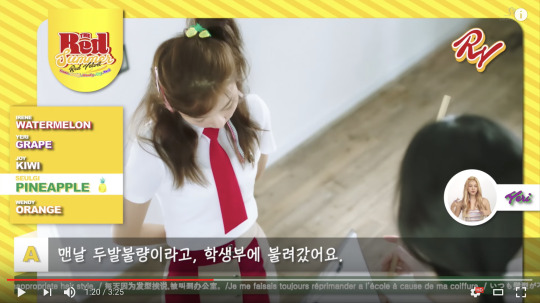
And Seulgi dressed as a school girl being reprimanded for her hairstyle. The ticker tape reads: I always got reprimanded in school for having inappropriate hair styles.
In reflecting upon their childhood, they imagine their present selves in that childhood context. Even though they act as they did when they were children, we know there’s something off with someone Seulgi’s age being reprimanded like a school child. In reliving their childhood memories, it only serves to show how much they’ve really grown and matured. We know that Seulgi won’t be chastised anymore for her hair, just like we know that Irene doesn’t wear her hair in watermelon pigtails and that Yeri doesn’t want to be jam anymore.


The coloring book pages and 100% grade also reflect childhood.
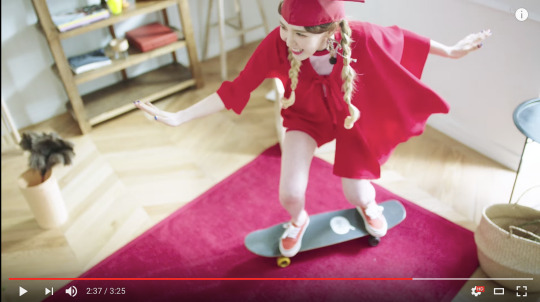
We see Wendy dressed in a cap and gown while playing on a skateboard. It’s a mix of childlike playfulness with young adult themes like graduation. This reflects the meeting of a childlike attitude with their current state of maturity in young adulthood as they move from one phase of life to another.

Throughout the video, the fruit is being picked, put into baskets, and having stickers put onto them. The fruit is being removed from their place of growth to be shipped out. The fruit is ripe and ready for consumption.
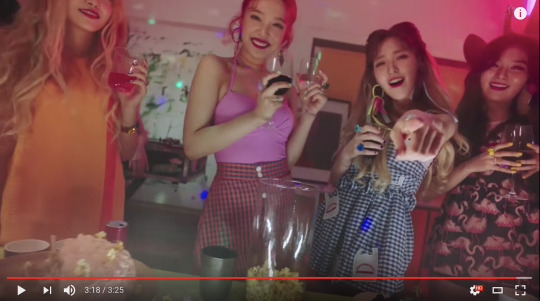
Just as the members are themselves reaching a stage in life where they can reflect on their childhood and still look forward to what is to come. They have reached the sweetest part of life. They’re ripe and ready to face the world that is to come. The adult-like nature of the party reflects this coming adulthood, as well. (Also, the little patches on Wendy’s dress are grocery store bags…like for fruit.)
150 notes
·
View notes






